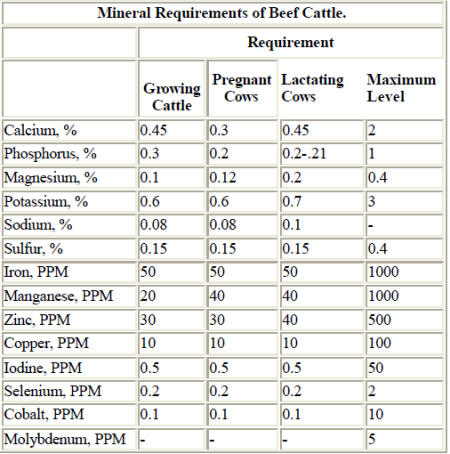



Minerals in Beef Cattle, Part 1
Strong immune systems, reproductive performance and calf weight gain are all influenced by mineral and vitamin nutrition. This article written by beef extension specialists at the University of Ohio looks at macro and trace minerals. Look out next week for a follow up article on mineral supplementation and vitamins.Mineral supplementation in beef cattle can be divided into two broad categories, macro-minerals and micro-minerals. These categories are based on the amount of mineral required in the cow's diet. Beef extension specialists at the University of Ohio, suggest that micro-minerals are required in amounts less than 1 gram per day compared to macro- minerals, which are often required at levels greater than 1 gram per head per day.

Macro Minerals
Salt: Forages do not contain adequate amounts of salt (sodium). Sodium can be supplemented as sodium chloride or sodium bicarbonate, and both forms are highly available.
Calcium: Vitamin D is required for active absorption of calcium. Forages are generally good sources of calcium, and legumes are higher in calcium content than grasses. Calcium can be deficient in mature or weathered forage. Similarly, small grain forage and grains, such as corn, are relatively low in calcium. Grains will contain about 0.03 per cent calcium and about 0.3 per cent phosphorus. Co-product feeds such, distillers grain products, corn gluten feed, and wheat middlings contain 0.5 per cent to over 1 per cent phosphorus.
When dietary phosphorus exceeds dietary calcium, absorption of calcium from the digestive tract is reduced. Animal in these situations will metabolise bone calcium to meet the requirement depleting phosphorus supplies at the same time.
'Water belly' or urinary calculi is caused by an imbalance of calcium to phosphorus which causes hard masses of mineral salts and tissue cells in the kidney or bladder. To prevent urinary calculi in growing male cattle, beef extension specialists recommend maintaining total dietary calcium to phosphorus ration of between 1:5:1 and 3:1. Cattle can tolerate calcium to phosphorus rations of up to about 7:1. Another method to prevent the disease is to make sure cattle total diet contains 0.5 - 4 per cent salt.
Grass tetany, related to a calcium deficiency, sometimes occur when pregnant and lactating cows graze lush cool-season forage, such as fescue, and small grains.
Phosphorus: Forage phosphorus concentration and digestibility declines with advanced maturity and weathering. Drought conditions and increased forage maturity (e.g., stockpiled forage) can result in lower forage-phosphorus concentrations. Therefore, phosphorus supplementation may become more critical in cases of winter grazing than feeding hay.
Phosphorus deficient animals will appear malnourished. Reproductive problems are common if phosphorus is deficient. Plasma phosphorus concentrations consistently below 4.5 mg/dL are indicative of a deficiency, but bone phosphorous is a more sensitive measure of phosphorus status.
Since phosphorus is a relatively expensive mineral, varying the phosphorus level during different times of the year is one means of saving money. Forage sampling for mineral content can be a money-saving activity in the long run.
Potassium: Potassium levels of 0.6 to 0.8 per cent of ration dry matter are considered adequate for cattle. Always check potassium levels of forage before adding any supplemental additions.
Magnesium and grass tetany: Grass tetany is most common in lactating cows grazing lush spring pastures. The reduction in standing forage magnesium concentration can be substantial during the winter months.
While phosphorus and magnesium may be in adequate amounts in the soil, plant uptake is slow due to the cool, wet conditions. Fertilising pastures with nitrogen and potassium is associated with increased incidence of grass tetany.
Grass tetany can occur more frequently older cows during early lactation than younger cows in the same pasture. Older cows are thought to be less efficient in mobilising magnesium reserves from bone compared to younger cows.
Fertilisation and grass tetany: As with all crops, proper pH is the most important factor in crop management. If the field has recently received manure, the importance of soil-test information cannot be overstated. At the rate used by some producers, a single manure application may supply several years worth of phosphorus, and sometimes potassium. Do not apply excessive rates of nitrogen early in the spring because high nitrogen levels can reduce magnesium availability in ruminants. Maintain relatively high soil- test phosphorus levels as some research has shown that phosphorus additions can increase tissue magnesium levels and potentially even decrease potassium uptake. Delay potassium application on grasses until late spring as high potassium fertilisation decreases magnesium uptake. Consider interseeding clover since legumes are higher in magnesium than grasses.
Sulphur: Sulphur is needed for synthesis of methionine and cystine, which are sulphur-containing amino acids, as well as the B vitamins, thiamin, and biotin. When urea or other nonprotein nitrogen sources are fed, sulphur supplementation may be needed. Mature forage, forages grown in sulphur-deficient soils, corn silage, and sorghumsudangrass can be low in sulphur. The typical nitrogen to sulphur ratio of a complete diet should be 10:1, nitrogen to sulphur.
The maximum tolerable concentration of dietary sulphur is estimated to be 0.4 per cent. Distillers grain products, soybean meal, corn gluten feed, and others, may contain 0.4 to 1 per cent sulphur , which makes sulphur analysis important.
Trace Minerals
Selenium: Selenium supplementation offers a narrow range between deficiency and toxicity. Selenium inclusion is federally regulated at a maximum inclusion level not to exceed 3 mg/day or about 0.14 mg/lb of total diet (0.3 parts per million (ppm)). This amount is equivalent to only 0.27 gm of total selenium per ton of feed.
Selenium deficiency will cause retained placentas, infertility, and white- muscle disease in calves. The normal cow requirement is 0.1 ppm. The toxic level for selenium is only 2ppm and any math error or mixing mistake can lead to serious consequences.
Selenium is generally supplemented in animal diets as sodium selenite, while selenomethionine is the predominant form of selenium in most feedstuffs.Vitamin E should be added to the diet along with selenium. Calves should be injected with a selenium- vitamin E solution at birth, where a problem exists. Alternate methods of supplementing selenium include injecting selenium every three to four months or at critical production stages and using boluses retained in the rumen that release selenium over a period of months.
Copper: Copper deficiencies can cause poor reproduction, broken bones, weak calves, and light colour hair.
Copper status in cattle is susceptible to a number of antagonists, including molybdenum, sulphur, iron, and zinc. Forage may contain an adequate levels of copper (approximately 10 ppm), but if the diet contains high levels of molybdenum (2 ppm) and sulphur (0.25), they can work together to tie-up copper, rendering a deficiency.
For molybdenum to exert an influence on copper, it is essential that an adequate level of dietary sulphur be available. When total dietary sulphur levels fall below .25 per cent, even high levels of molybdenum may not be a problem with copper absorption. Beef extension specialists say that if copper: molybdenum ratios are less than 4-5:1 and total dietary sulphur is greater than .25 per cent then a potential molybdenum induced copper deficiency is likely. The dietary copper to molybdenum ratio should be maintained between 4:1 and 10:1 in order to minimise the risk of molybdenum induced copper deficiency.
Copper and zinc are absorbed through similar pathways indicating a competition for absorption sites. Therefore, mineral supplements should be formulated with a copper: zinc ratio of around 1:2 or 1:3.
When formulating mineral supplements for Simmental, Limousin, Charolais, or Maine-Anjou cattle and their crosses, it is important to remember that their requirement for copper is 1.5 times higher than the base requirement (10 ppm). Similarly, Jersey and Brahman cattle are more susceptible to copper toxicity.
Iodine: Iodine is critical for the maintenance of proper thyroid function. The iodine requirement is 0.2 to 0.3 ppm in the total diet.
Zinc: A zinc deficiency can affect reproduction, the skin, and hoof problems and cause swelling of the bone joints or slow healing of wounds. Zinc deficiencies tend to impair sperm production and sperm quality in bulls. Most forages are marginal to low in zinc concentration compared to the suggested requirement. Cows require 30-40 ppm zinc with diets containing 2-10 ppm considered deficient. Legumes are generally higher in zinc than grasses.
Iron: In general, iron deficiency is unlikely unless parasite infestation or disease exists and causes chronic blood loss. Availability of iron from forage appears to be lower than from most supplemental iron sources. Iron is normally supplemented in the diet as ferrous sulfate, ferrous carbonate, or ferric oxide. However, ferric oxide is basically unavailable and is used simply as a coloring agent.
Manganese: Although dietary manganese absorption and retention in cattle is low (20 per cent), manganese deficiency in grazing cattle is uncommon. Manganese requirements are approximately 40 ppm.
Considering the importance of manganese on cow fertility and young calf development, it is most important to focus on optimal manganese nutrition prior to and following calving. Manganese sulfate is the most available form of manganese, but it is often difficult to find commercially. As an alternative, manganese oxide is an acceptable. High intake of phosphorous, calcium, and iron results in reduced manganese absorption.
Cobalt: Cobalt is essential to ruminants through its participation in the ruminal synthesis of vitamin B-12. Cobalt affects reproduction, growth, and causes pale skin (anemia). Cobalt supplementation plus an injection of vitamin B-12 should alleviate symptoms. Young rapidly growing cattle seem more susceptible to cobalt deficiency than mature cattle.


